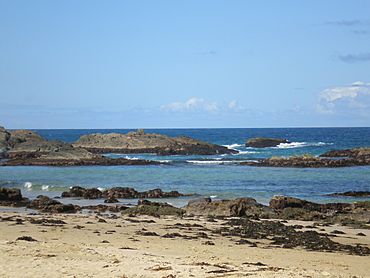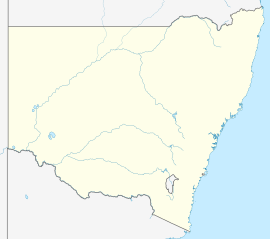Mystery Bay, New South Wales facts for kids
Quick facts for kids Mystery BayNew South Wales |
|
|---|---|

A beach at Mystery Bay
|
|
| Population | 191 (2016 census) |
| Postcode(s) | 2546 |
| LGA(s) | Eurobodalla Shire |
| State electorate(s) | Bega |
| Federal Division(s) | Eden-Monaro |
Mystery Bay is a small town on the south coast of New South Wales, Australia. It is located between Central Tilba and Narooma. You can find it just two kilometres off the Princes Highway.
In 2016, only 191 people lived in Mystery Bay. The area is famous for its camping spot within the Eurobodalla National Park. This park is great for outdoor activities and seeing different kinds of Birds. Nearby, Montague Island is home to many Little penguins and fur seals.
Contents
Why is it Called Mystery Bay?
Mystery Bay got its name from a strange event in 1880. Five men disappeared without a trace! A geological surveyor named Lamont Young, his friend Louis Schneider, and three boatmen were using a boat to reach a goldfield. Their boat was found damaged and empty at Mystery Bay.
Some food and personal items were still in the boat. But the holes in the boat looked suspicious. No one ever found the men. A special memorial stands there today to remember this mysterious event.
Amazing Beaches and Ancient Rocks
Mystery Bay has many different types of beaches. These beaches face the Tasman Sea. Some are perfect for surfing, while others are calm for swimming. Many beaches have huge, amazing rocks.
When the tide is low, these rocks create cool rock pools. The rocks and sand along the coastline show signs of past tsunamis. Even today, the local Indigenous community enjoys fishing and camping here.
Evidence of Past Tsunamis
There is clear evidence of historical tsunamis along the central South Coast of New South Wales. Mystery Bay shows the most obvious signs of tsunami damage. You can see many misplaced rocks and sand from these powerful waves.
Evidence of tsunamis is common along Australia's coast. In 2006, scientists found about 44 tsunamis had hit New South Wales over the last 105,000 years. One big event was the 1960 Chilean tsunami. It was caused by an earthquake in Chile. This tsunami affected Victoria, Queensland, and the north coast of New South Wales.
Fun Places to Visit Nearby
Eurobodalla National Park Wildlife
The Eurobodalla National Park is a special place for wildlife. It is home to the majestic white-bellied sea eagle. This large bird of prey is a beautiful sight to see.
Another bird you might spot here is the Australian pelican. These large birds are found all over Australia and nearby Pacific islands. Pelicans love coastal areas and fresh water like lakes and rivers. They can fly very high, up to 3000 meters, and reach speeds of about 56 kilometres per hour!
Montague Island's Unique Animals
Barunguba / Montague Island is famous for its wildlife. It has many Little penguins and fur seals. The number of penguins has grown a lot since 1982. This is partly because of changes to the plants on the island.
Many colonies of little penguins live along Australia's coast. The east coast, where Montague Island is, has many of them. More penguins breed in the southern parts of Australia.
Protecting Montague Island's Ecosystem
Montague Island also has a large population of house mouses. In recent years, their numbers grew too much. Scientists had to find ways to remove them. These mice were eating seeds and harming the island's plants.
Scientists looked at other islands with similar mouse problems. They found that mice on those islands damaged animal and plant species. The mice ate lizards and many plant seeds. This upset the natural balance of the ecosystem.
Plants of Mystery Bay
Mystery Bay and its surrounding areas have many native plants. One plant that has caught attention is the Coastal wattle (Acacia sophorae). This flower is native to the Mystery Bay region. It is often found in Eurobodalla National Park.
In recent years, this wattle has spread quickly. This is causing concern because it might take over and reduce other plant species. Scientists are working to understand and manage this spread.
Challenges for Coastal Plants
Coastal wattle is common in the forests and bushland of southeastern Australia. Recently, a type of powdery mildew has been seen on its leaves. This mildew is an infection caused by pathogens from other countries.
Weeds along Australia's coastline are a big problem. The Australian government has invested money to remove them. These weeds can harm sand dunes, cause animal extinctions, and even damage coastal towns.
Plant Life on Montague Island
Montague Island, near Mystery Bay, has many different plant species. In 1932, over 200 types of plants were recorded. By the late 1990s, only about 140 remained. Many of the plants that disappeared were weeds.
In the 1980s, goats on Montague Island caused problems for the plants. The number of goats almost doubled. Goats eat a lot of plants. This led to an increase in certain plant species that were harmful to the island's natural environment. One such plant, Pennisetum clandestinum, took over a large part of the island.
Aboriginal History and Culture
Aboriginal Australians lived in this area for thousands of years before European settlement. Today, fewer Aboriginal residents live directly in Mystery Bay.
Camping and fishing are very popular activities for the Aboriginal community at Mystery Bay. The area holds many important Dreamtime stories. Aboriginal people camping here often live off the land. They follow special "dreaming tracks" that were created during the Dreamtime. These tracks helped them find food along the coast and meet at different campsites.


